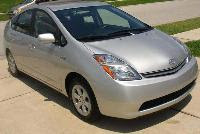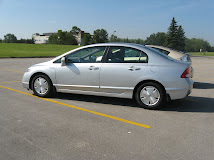Ok, for the 1000th time: Driving in electric only is NOT desirable if your goal is to have the best fuel economy and emissions possible !
Why would this be? Isn't this the objective when buying a hybrid vehicle to begin with?
Answer: NO. The main reason why it is not a good idea is because the energy contained in the battery pack was acquired as a result of a slow down (braking) or through a forced regeneration (gas engine charging the battery pack).
The means to greater fuel economy is steady and lower speeds and a desire to conserve momentum (remember your high school physics?). Furthermore, the energy you place into the battery pack is far greater than what you'll get out. This happens because of the energy conversion losses and the more exchanges are there between the battery pack and its upstream and downstream systems the greater the losses.
For the more technical, these losses manifest themselves in the form of heat generation, internal resistances, parasitic interferences and frictional losses.
With this said, hybrids are still more efficient than regularly powered vehicles because they recover energy whereas the others would simply waste it all away in the form heat and friction.
The other point I want to touch on:
A Prius is good for 2.9-3.9L/100km in city duty. On the highway, you should be able to get at least 4.4 l/100km.
A Civic hybrid is good for 3.6-4.1 L/100km on the highway. You can also get this performance in city driving but you have to throw the entire hypermiling book at it (forget eco-driving).
Remember, speeding (traveling at or above the posted speed limit) is a sure way waste fuel and traveling at more than 100km/h (62 MPH) should be avoided.
If you own any of these cars and you are are not getting the mileage I mentioned then it is time to learn a few more tricks about your car, but the simplest you can learn is still to stay off the battery pack. I cannot stress this enough.
Sunday, January 28, 2007
Tuesday, January 9, 2007
Winter driving In a hybrid vehicle
Temperature is the key.
The fuel economy losses due to cold weather especially sub-freezing temperatures are not just limited to conventionally powered vehicles. Hybrid vehicle's with their downsized internal combustion engines are particularly vulnerable and more susceptible to significant energy losses.
That is why many owners of fuel efficient hybrids report terrible fuel economy achievements during the cold spells. They note anything from a gas engine not stopping any longer and electric only operation being nearly impossible for weeks and even months in some places.
However, does this mean that a conventionally powered vehicle would do better in similar circumstances? Certainly not. Even with the detriment of cold temperature operation a hybrid will always be more efficient in part because its small engines running on closed loop operation (the initial stage of warm-up for modern fuel injected vehicles) will still consume far less fuel than their conventional counterparts.
OK, so is there anything hybrid owners can do to soften the cold weather blow to their fuel economy and emissions?
Fortunately there is. Lets just cover some of the most important:
After doing all this and perhaps a bit more, how much improvement can we see in our fuel economy?
Depending on how far you go, you could see very significant improvements. For instance, if you typically get, say 8 liters/100km during the coldest days in short drive commutes, with these techniques you'll see a 1 to 3 L/100km improvement. Not too bad at all if you consider what most other conventionally powered vehicles achieve under similar circumstances. ;)
The fuel economy losses due to cold weather especially sub-freezing temperatures are not just limited to conventionally powered vehicles. Hybrid vehicle's with their downsized internal combustion engines are particularly vulnerable and more susceptible to significant energy losses.
That is why many owners of fuel efficient hybrids report terrible fuel economy achievements during the cold spells. They note anything from a gas engine not stopping any longer and electric only operation being nearly impossible for weeks and even months in some places.
However, does this mean that a conventionally powered vehicle would do better in similar circumstances? Certainly not. Even with the detriment of cold temperature operation a hybrid will always be more efficient in part because its small engines running on closed loop operation (the initial stage of warm-up for modern fuel injected vehicles) will still consume far less fuel than their conventional counterparts.
OK, so is there anything hybrid owners can do to soften the cold weather blow to their fuel economy and emissions?
Fortunately there is. Lets just cover some of the most important:
- Keep the gas engine RPMS down especially during the warm-up stages. Yes, your accelerations will be slower than usual but if you watch your instantaneous fuel economy display you'll notice that it takes little pedal pressure to hit the depressing numbers. The strategy during these warm up stages is to let the higher engine RPM power the car forward with the least amount of throttle pressure. Yes, it is a little slow but full of goodness.
- Avoid setting the climate control temperature to a high value. In fact, you should set it to its smallest value possible!! This will help the car warm up even faster. When it does, tyou be warming up too in no time. This is yet another case where less is more.
- Block your front intake grille. There are many ways of achieving this but whatever means you choose, make sure that it is not just effective but also safe. A popular choice is to use foam pipe insulation typically found in the plumbing section at most hardware stores.
- If your car has a block heater installed, use it. It will do wonders for your vehicles durability and fuel economy.
- Check your tire pressures. When it is cold the tire pressures are reduced and that induces unnecessary drag as the vehicle moves. Bumping the tire pressures to their maximum rated pressure will help offset the fuel economy losses of winter.
After doing all this and perhaps a bit more, how much improvement can we see in our fuel economy?
Depending on how far you go, you could see very significant improvements. For instance, if you typically get, say 8 liters/100km during the coldest days in short drive commutes, with these techniques you'll see a 1 to 3 L/100km improvement. Not too bad at all if you consider what most other conventionally powered vehicles achieve under similar circumstances. ;)
Subscribe to:
Posts (Atom)





